Museum-Quality QUEZAL Art Nouveau 7-Shade Ceiling Lamp c. 1904 antique glass
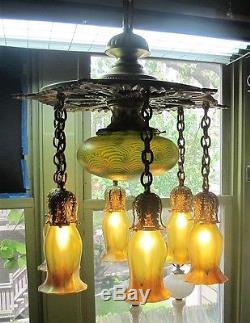
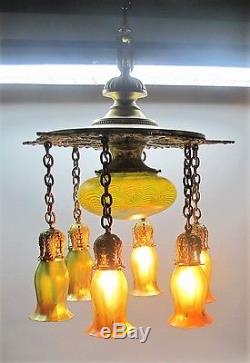
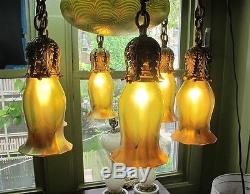
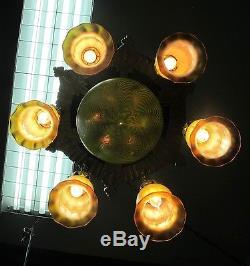
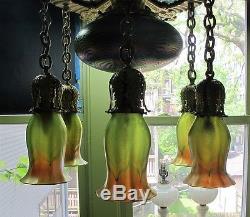
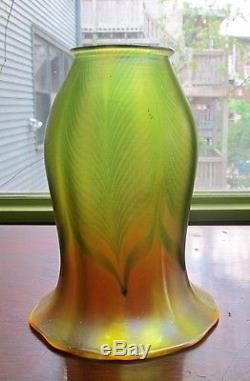
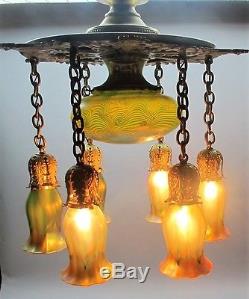
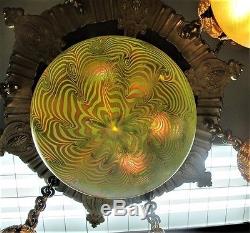
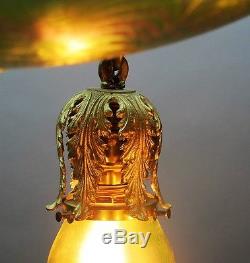
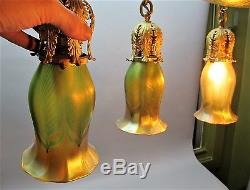
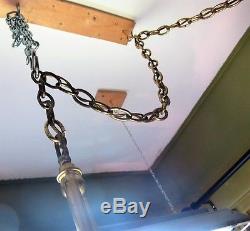
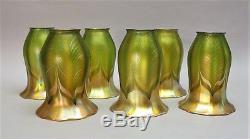

Museum-Quality QUEZAL Art Nouveau 7-Shade Ceiling Lamp c. Museum-Quality QUEZAL Art Nouveau 7-Shade Gilt Bronze Ceiling Lamp , circa 1904. FREE PICK-UP IN THE CHICAGOLAND AREA. Up for your consideration is one of the finest Quezal ceiling lamps ever produced. Based on the etched signatures, glass quality, and design, the lamp proves to be a very early Quezal piece, likely within the first few years of the firm c.
Based on expert examination, it is believed that the glass was blown by the founders, themselves. The lamp is custom made, with the brass fitter for the central platfonnier shade added to a very heavy gilded spelter and brass fixture with 6 iridized glass panels. It weighs about 30 lbs. After extensive research, this is the only 6 shade + platfonnier fixture I have seen from this maker, and Steuben and Tiffany did not make ceiling lamps in this style with the large central shade, and drop shades, so this is likely the best you are going to find.
The 6 iridized panels at the top of the fixture are also interesting, I have never seen these before. As you can see (there are about 30 pictures), the central shade is green with platinum coils in a "King Tut" pattern, identical in color to Tiffany Damascene. It was specially blown to have the pattern emanating from the center bottom, showing the fine craftmanship of the talented gaffer. The shade measures 10.25 in diameter. There is a single small chip to the fitter rim by the etched signature (as shown), that is completely hidden when the shade is in place.
The 6 drop shades are fine works of art, with finely feathered green and gold shades. The iridescence is graduated, with the bottom opening being heavily iridized, and the upper portion being purposefully lighter. This meticulous attention to detail gives the beautiful Art Nouveau "organic" effect that became lost in later shades. The shades are 6" tall, and 4.25" wide at the base, a nice slender effect. All shades are precisely decorated, and nearly identical in decor, shape, iridescence, coloring and size. Because they are hand-blown and go through a variety of processes, the only way to have such similarity is if many were blown, and only the 6 best examples were retained. All 6 shades are in excellent condition, free of chips, cracks, damage, or restoration. There is no ceiling cap, as it is supported by a long heavy chain (about 20' long) and can be supported by a simple hook rather than requiring an electrician.The entire fixture is supported by the chain, which has a wire running through it and a plug an the end. It has been professionally rewired, and ready for immediate use. There are two stabilized cracks in the spelter (see last two photos), they do not seem to have an impact on the structural integrity of the piece, and they may have been made during manufacture to help accommodate the fitter for the platfonnier shade.
As stated before, the piece has custom aspects to it. The six iridized panels are free of chips or cracks. The gilt is bright throughout the mounts. The fixture has a 25" drop, and is 23" wide.
The Quezal Art Glass and Decorating Company was organized by Martin Bach, Sr. And Thomas Johnson in February 1901.
Bach, a French immigrant, had been a formula mixer for Louis Comfort Tiffanys Corona, New York, glass factory. Johnson, a skilled glassblower, had also been employed by Tiffany. The separate departures of the two men from Tiffany were due to their individual difficulties with the management.
It took the knowledge and expertise of both men to form their new glass factory, located on Fresh Pond Road and Metropolitan Avenue in Brooklyn, New York. What is acknowledged is the similarity in form, color and iridescence of Quezals early production to Tiffanys glassware. The resemblance was so much the same, it was said to have angered Tiffany. The likeness is understandable, considering the backgrounds of Bach and Johnson. Other gaffers, such as Maurice Kelley, also worked at both firms. The Quezal factory was Tiffanys first real competition in the United States in the artistic blown glass field. It would be two more years before the other major competitor, Frederick Carder, would open the Steuben Glass Works in Corning, New York. The enduring hallmark of Quezal art glass is its unique expression of the Art Nouveau style, based on organic shapes and naturalistic motifs coupled with technical perfection in the execution. Vases, compotes, drinking vessels, and shades for lighting fixtures were often fashioned to resemble flowers such as crocuses, tulips, calla lilies, casablanca lilies, and jack-in-the-pulpits. Compared with Tiffanys Favrile glass, the crisp, vivid, and colorful decoration of Quezal art glass is distinctively precise, symmetrical, and restrained. This quote is for the Continental U. Only, and the item will be sent via UPS. These charges are the buyers responsibility. FREE scheduling, supersized images and templates.Make your listings stand out with FREE Vendio custom templates! Over 100,000,000 served. Get FREE counters from Vendio today! The item "Museum-Quality QUEZAL Art Nouveau 7-Shade Ceiling Lamp c. 1904 antique glass" is in sale since Tuesday, July 11, 2017.
This item is in the category "Pottery & Glass\Glass\Art Glass\North American\Other North American Art Glass". The seller is "thesapphiregallery" and is located in Chicago, Illinois.
This item can be shipped to United States.
- Brand: Quezal
- Object Type: Chandelier
- Original/Reproduction: Antique Original
- Type of Glass: Favrile
- Manufacturer: Quezal
- Style: Art Nouveau

